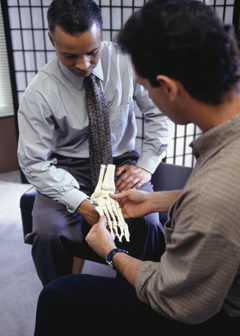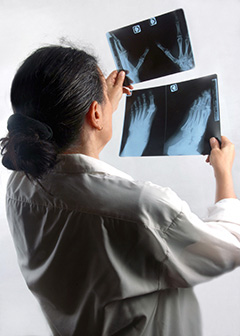
Podiatrists listen to a patient’s concerns about their feet, ankles, or lower legs.
Becoming a podiatrist requires completing an undergraduate college education, a 4-year postgraduate degree, and a 3-year medical and surgical residency. Podiatrists also must be licensed.
Education
Podiatrists must have a Doctor of Podiatric Medicine (DPM) degree, which is a 4-year degree after earning a bachelor’s degree. Admission to podiatric medicine programs requires at least 3 years of undergraduate education, including specific courses in laboratory sciences such as biology, chemistry, and physics, as well as general coursework in subjects such as English. In practice, nearly all prospective podiatrists have earned a bachelor’s degree before attending a school of podiatry. Admission to DPM programs usually also requires taking the Medical College Admission Test (MCAT). In 2011, there were nine colleges of podiatric medicine in the United States.
Courses for a Doctor of Podiatric Medicine degree are similar to those for other medical degrees. They include anatomy, pharmacology, and disease pathology, among other subjects. Also, during their last 2 years, podiatric medical students must complete clinical rotations, where they gain supervised experience in hospital settings, in specialties such as general surgery and emergency medicine. After earning a DPM, podiatrists must apply to and complete residency programs, which last 3 years. They may do additional training beyond 3 years in specific fellowship areas. Residencies allow for additional training in a clinical setting.
Important Qualities
Critical-thinking skills. Podiatrists must have a sharp, analytical mind to correctly diagnose a patient and determine the best course of treatment.
Detail oriented. To provide safe, effective healthcare, a podiatrist should be detail oriented. For example, a podiatrist must pay attention to a patient’s medical history as well as current condition when diagnosing a problem and deciding on a treatment.
Interpersonal skills. Because podiatrists spend much of their time interacting with patients, they should be able to listen well and communicate effectively. For example, they should be able to tell a patient who is slated to undergo surgery what to expect and calm his or her fears.
Licenses
Podiatrists must be licensed in every state. Licensure usually requires passing a state exam (written or oral) and paying a fee. In most states, podiatrists also must have completed a residency program to be licensed. Licenses must typically be renewed periodically, and podiatrists must take continuing medical education.
Certification
Many podiatrists choose to become board certified, either in podiatric surgery or in orthopedics and primary care podiatry. The American Board of Podiatric Surgery is the certifying agency in podiatric surgery, and the American Board of Podiatric Orthopedics and Primary Podiatric Medicine is the certifying agency in orthopedics and primary care podiatry. Certification requires a combination of work experience and passing scores on exams.










